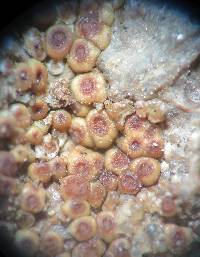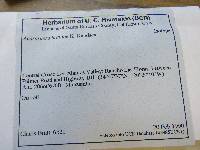
Consortium of Lichen Herbaria
- building a Global Consortium of Bryophytes and Lichens as keystones of cryptobiotic communities -
- Home
- Search
- Images
- Species Checklists
- US States: O-Z >
- US National Parks
- Central America
- South America
- US National Parks
- Southern Subpolar Region
|
|
|
|
Family: Acarosporaceae
|
Nash, T.H., Ryan, B.D., Gries, C., Bungartz, F., (eds.) 2007. Lichen Flora of the Greater Sonoran Desert Region. Vol 3. Thallus: areolate to verruculate, covering several cm areoles: irregular or round, 0.3-1.5 mm across, mostly 0.5 mm thick, dividing repeatedly, usually made up of two to ten contiguous verrucae, 0.1-0.5 mm across, or verrucae separate though eventually dividing, sometimes appearing lobed in early stage of division, with occasional discs expanding and reducing verruca to a thalline margin, 0.4-0.5 mm across, broadly attached, sometimes becoming elevated; rim: down-turned upper surface: light brown, dull, convex, initially smooth but becoming striate in a radial pattern around disc, or wrinkled to rugulose, sometimes blackening around disc, epruinose cortex: paraplectenchymatous, 35-40 µm thick; syncortex: evident but thin and uneven; eucortex: upper layer with dark reddish pigment, 5-10 µm thick; lower layer: hyaline, rather indistinct in water algal layer: 50+ µm thick, even, upper stratum with no clear interruptions of the layer, eventually spreading around apothecium as it fills the verruca medulla: white, prosoplectenchymatous, continuous with attached hyphae lower surface: white, ecorticate to subcorticate attachment: broad, but, thickening above the substrate, elevating areole or verruca (gomphate), lacking a stipe Apothecia: one per verruca or unit of areole, usually round disc: usually dark brown, flat, immersed, rough, epruinose, 0.1-0.3 mm across parathecium: prosoplectenchymatous, c. 30 µm wide, IKI+ reddish yellow, expanding near surface up to 60 µm, forming a parathecial crown epihymenium: dark reddish brown, conglutinate in pigmented gel, c. 15 µm thick hymenium: hyaline, 150-200 µm tall, IKI+ blue; paraphyses: mostly 2 µm wide at mid-level, apices expanded to 4 µm, with or without dark pigment cap, often in pigment hood subhymenium: indistinct, 10-15 µm thick; hypothecium: 30-50 µm thick asci: clavate, (90-)120-130 x 30-45 µm, 100+ spored ascospores: hyaline, simple, ellipsoid but variously shaped, mostly 4-5 x 2 µm Pycnidia: not observed Spot tests: UV-, K+ yellow turning red, forming crystals (in mount) Secondary metabolite: norstictic acid, concentrated in cortex and parathecium. Substrate and ecology: on consolidated soil in Los Alamos Valley in the wine country World and Sonoran distribution: known only from the type locality in southern California. Notes: Acarospora brattiae with its small verrucae, its deep hymenium, its terricolous habit, and norstictic acid is distinct from other known species with the same chemistry. An areole formed of many dividing units looks superficially like a member of smaragdula group but individual verrucae are somewhat similar to A. obpallens. Apothecia do not appear to arise from pycnidia. The holotype was glued but it looks like it has very fine rhizohyphae. Like several other terricolous Acarospora, it probably spreads with anastomosing rhizohyphae. The type collection is in central California at the very edge of the Sonoran study area and may be in the south end of its range. But many terricolous lichens are rare in California because of development or degradation of their habitats, especially by grazing, invasive weeds, and nitrate pollution. The consolidated soil, on which the holotype grows, is quite hard, and therefore it may grow on rock too. Several species of lichen that normally grow on soil, like Acarospora obpallens, are often collected now on rock because of reduction of soil habitats. |
Powered by Symbiota












